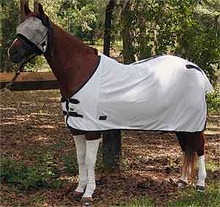With warmer weather approaching in many areas, horse owners should be thinking about how best to control the growing swarms of flies and insects that bring annoyance, misery, and diseases to their horses during the summer season.

Protecting your horse from flies
Horse owners should be thinking about how best to control the growing swarms of flies and insects that bring annoyance, misery, and diseases to their horses during the summer season.
© 2012 by Sox for Horses
Before taking preventative measures, it is necessary to know what insects are in the environment and the best ways to deal with various fly populations.
Horseflies, deerflies, stable flies and horn flies are the most common tabanids and come in a variety of shapes, colors and sizes. When they bite to ingest blood, the bites are not only painful, but they open the way for screwworm attacks and infection.
Blood-sucking gnats such as the black fly (buffalo gnat) and "no-see-ums" are very irritating to horses and cause head-tossing, ear-twitching and incessant biting or rubbing. Bites from gnats ooze serum and form scabs or blisters. Black flies secrete a toxin capable of causing cardiac and respiratory depression.
Non-biting flies include the housefly, bot fly, and face fly. Although they do not "bite," they cause great discomfort by feeding on secretions from the eyes, nose, and mouth. These species carry diseases including equine infectious anemia, anthrax, contagious conjunctivitis and eyeworms. The bites of the stable fly produce skin lumps that are called external parasitic nodules. The nodules become worse when rubbed.
Blowflies and screwworm flies lay their eggs in open wounds with the navel stump of the newborn being a favored site. The eggs develop into maggots that lead to irritation and infection.
Minimizing the fly population by getting rid of or covering up their favorite breeding environments is the best prevention of fly bites.
- Removing manure daily and keeping it dry by spreading it will eliminate a major source.
- Covering manure piles and compost with plastic and cleaning up spilled hay, grain and trash is also very helpful. Commercial pelleted and mineral block feed additives such as Rabon, Endrol, and Equitrol are said to safely pass through the horse's system and kill larvae in fresh manure.
- Eliminating stagnant pools, scrubbing out feed bins and buckets, and keeping feed bags and bins closed will keep flies from feeding from these sources. Trash should be kept covered and as far away as possible from barns and stalls. When setting up horse facilities, care should be taken to stay away from wet, low-lying areas.
- Fly traps, fly paper, and other commercial fly bait/capturing devices may be used to cut down on fly populations. In addition, an automatic misting system in the barn/stall areas and an on-going chemical warfare campaign making use of pyrethrins and resmethrins which are toxic to many insects, but considered safe for warm-blooded animals can be very effective.
- Insect repellants formulated for equine use are a good addition to the supply kit and can be used whenever needed to keep the horse from being bitten.
- Residual insecticide surface sprays provide long-term results. Labels should be studied to determine the product's effectiveness and safety.
- No insecticide should be used on horses unless they are specifically recommended for that purpose. Many of these products should not be inhaled, ingested, or allowed to make contact with skin and eyes, so care must be taken when using insecticides.
- Topical insecticides containing pyrethrins and permethrins can be applied according to label instructions as necessary to control flies and external parasites. Some topical insecticides can be wiped or sprayed on the areas where flies tend to congregate. A light spray to the shoulders, neck and withers is often sufficient, but application to the lower body and legs can also help prevent fly bites.
- Stabling horses before sunset can also be helpful since many biting insects are most active in the evening. The use of face masks and light coverings to protect the body of the horse can be effective.
- Controlling where flies can land by means of sheets, face masks, and leg wraps will help keep flies off horses, especially around the sensitive eye, ear and nose areas can be helpful also. A coating of petroleum jelly applied to the skin is also a good protectorant.
Learn more about the Use of Repellants and Insecticides for fly control
